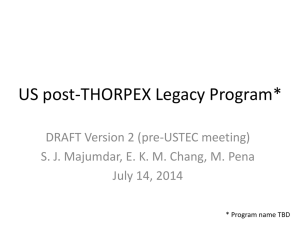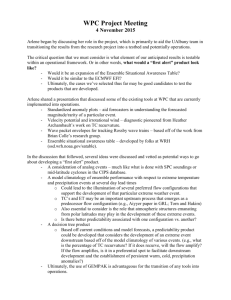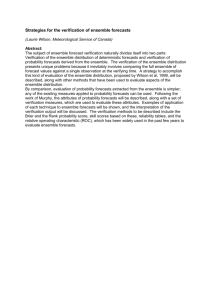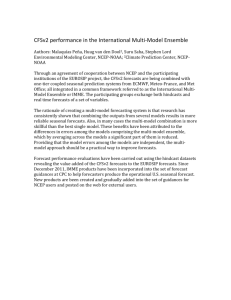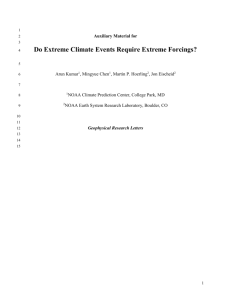Dr. Sharan Majumdar
advertisement
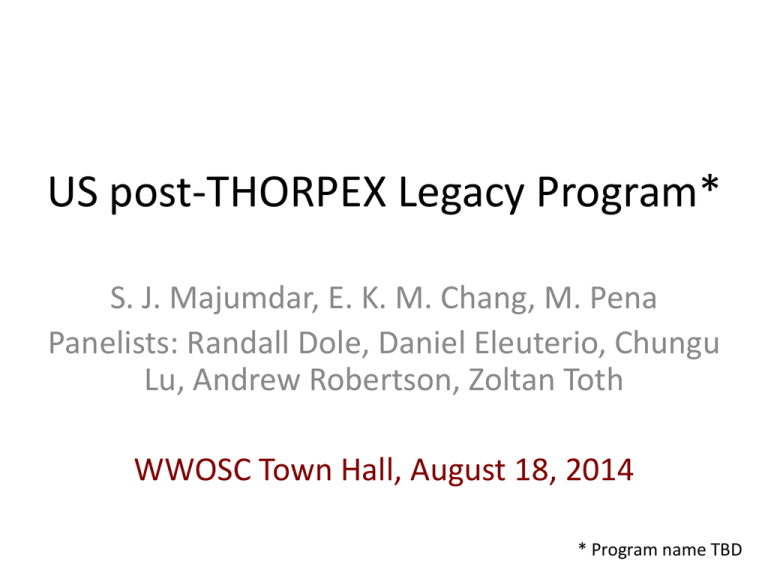
US post-THORPEX Legacy Program* S. J. Majumdar, E. K. M. Chang, M. Pena Panelists: Randall Dole, Daniel Eleuterio, Chungu Lu, Andrew Robertson, Zoltan Toth WWOSC Town Hall, August 18, 2014 * Program name TBD June 5-6 Planning Meeting June 5-6 Planning Meeting • • • • Summary of THORPEX, successes, challenges Introduction to WMO/WWRP Legacy Projects Service, Agency, Participant priorities Participants identified critical gaps in progress, common scientific challenges and research priorities in the context of the new Legacy projects • Next step: to develop a coordinated community program plan for US research • These slides offer an initial structure to begin planning the new US program, and the community is invited to contribute to the plan. Program Name (TBD) Consider minutes-to-seasonal prediction, high-impact weather, spanning predictability through to forecasting and socio-economic impacts. Name needs to be short. Mission “To promote national and international cooperative research to understand, evaluate, and improve the skill and socio-economic value of forecasts of high-impact weather events, on time scales of minutes to seasonal.” Goals • Determine and address US needs over next decade – Socio-economic and environmental needs – Agency interests – US community research priorities and talent • Determine scientific opportunities highlighted in the 3 international legacy projects that map on to interests of US community and agencies, including science that cuts across the legacy projects • Prepare a coordinated effort to collaborate and communicate results with performance metrics • Devise a cohesive yet far-reaching, fiscally responsible plan driven by short-term and long-term benefits WMO/WWRP International Legacy Projects Minutes 2 weeks Seasonal WMO/WWRP International Legacy Projects • Polar Prediction Project (PPP) http://polarprediction.net/ • Subseasonal to Seasonal Prediction (S2S) http://www.wmo.int/pages/prog/arep/wwrp/new/S2S_project_main_page.html • High-Impact Weather (HIWeather) http://www.wmo.int/pages/prog/arep/wwrp/new/HIW_Silver_Spring_2014.html • All three legacy projects focus on aspects of prediction of high-impact weather One atmosphere, all spatial / temporal scales connected Subjects of Legacy projects overlap US Plan in context of International Legacy Projects • US research plan can integrate elements from all 3 international projects – Focus on subset of research issues specified in the 3 international documents for which US community can speak for • Community experts in each area to define research priorities • Develop linkages in parallel as these priorities are identified – Prediction priorities lie geographically both within and outside the US, can be global problems, mapped onto interests of US agencies – Identify tasks that a large group of scientists all deem important, that a coordinated effort can achieve that improves upon small groups of PI’s • Scientific collaborations • Data management and archival of observational and model/ensemble data • Create mechanisms to integrate collaborations with international partners on legacy projects – Articulate US benefits but think more broadly – How will the US contribute to international efforts, and how will international collaborations and activities benefit the US goals? Hazards: WMO / WWRP HIWeather Foci 5 hazards have been proposed as anchors for collaborative international research activities: • • • • • Urban Flooding Wildfires Localized Extreme Wind Disruptive Winter Weather Urban Heat and Air Quality Hazards: Proposed US Foci • Priorities identified at US Planning Meeting – – – – Water (all flooding, surge, ice etc.) (PPP, S2S, HIWeather) Heat waves (S2S, HIWeather) Winter weather (PPP, S2S, HIWeather) Extreme Wind (PPP, S2S, HIWeather) • Activities seamlessly span space and time scales – Minutes to seasonal – Micro-scale to planetary scale • Develop planning process around these priorities • Additional areas matching agency interests may be identified Research Thrusts • The primary goals that were identified fall into 4 broad and overlapping research thrusts: – Predictability and Processes • Process-oriented, multi-scale predictability studies – Modeling and Assimilation • Coupled high-resolution modeling and assimilation for NWP foundation; ensemble science and prediction – Use and Evaluation of Forecasts • New forecast products, methods to evaluate forecasts and assessments of value to users – Risk, Impact and Communication • Communication to and from users and decision makers Cross-Cutting Activities • The following activities cut across the aforementioned research thrust areas: – Creative use of Observations • New observing networks • Better utilization of existing observations – Uncertainty • Assessments of uncertainty in predictions and communications – Testbeds and Virtual Field Campaigns • Where the rubber meets the road • Operational models as community models – Data Management • Dedicated data management and support desk essential Next slide • In each box: summary of activities suggested at June 2014 Planning Meeting, arranged by research thrust and cross-cutting activity • Activities are common across all of PPP, S2S and HIWeather (and interfaces between) • Several activities belong to more than one box • Slides at end (background): selected activities specific to each of PPP, S2S and HIWeather. Risk, Impact and Communication Ocean, PBL, surface, microphysics. Lowertropospheric & satellite obs. Coupled, multiscale, non-linear DA. Model error and bias. Novel verification of coupled global, cloudpermitting NWP using obs. Linkages between research and operations. Common requirements. Better observations of hazards: flooding, wind. Identify decision makers’ needs for observations and nowcasting. Assess health risks. Which advances will yield better ensembles? Predictability manifested in risk assessments? Model sensitivity and stochastic variability. Ensemble development and calibration. User-focused metrics to evaluate value contained in ensemble forecasts. Multi-model ensembles. New products and metrics for hazards. Coordinated assessment of ensemble reliability. User-based relative value on different scales. How do Spatio-temporal scales of met forecasts intersect with those of human response? “Social DA”. Examining communication to users. Predictability and process studies in virtual global and regional field experiments, real-time and retrospective. Precipitating regimes. Testbed for coordinated developmental testing. Operational models/DA for community use. ESPC, NUOPC, NMME. NOAA Testbeds. OSSE. Provide large set of case studies for HIW and S2S, including Arctic (PPP). Event-based verification. Evaluate if impacts are being reduced. Test information needed to personalize risk. Examine propagation of forecast/warning/risk. Predict user impact for different forecasts.WRN Special archives for high impact cases: Observations. Reanalysis and reforecast data. Ensemble data. Model data at its highest resolution. Model scripts, code and executables. Data assimilation scripts, code and TIGGE protocol. Verification toolbox. GIS database. Easy access to product visualization. Creative use of observations Large-scale linkages to high-impact events. Influence of and on convective processes. Regime dependence. Limits of predictability. Uncertainty Use and Evaluation of Forecasts Testbeds and Virtual Field Modeling and Assimilation Data management ALL Predictability and Processes Operational linkages: R2O and O2R • Where the rubber meets the road • Two-way interface – Successful research activities and products that demonstrate a quantitative benefit for operations are considered for operational use – Researchers are provided with infrastructure, access and sufficient support to use operational models and products • Many activities listed on the previous slides are considered in the context of R2O and O2R Next Steps: Key Science Questions • Following the establishment of priorities that were proposed at the Planning Meeting, the next step will be for the US community to develop a coherent series of nationally focused science questions that span across the legacy projects. • These will be developed through the next year. Next Steps: Key Practical Questions • How to establish metrics for success? – NOAA’s HFIP has clearly established metrics and targets, offers their community a focus • How to coordinate existing and new projects? – Currently, a large number of individual relevant projects and products • How to dedicate resources: infrastructure and personnel support? – Support for operational models currently poor • How to foster direct science-SERA collaborations? • How to handle cross-cutting projects across agencies? • How to link (and lead?) international collaborations? Timeline for developing US plan • August 18 2014 – WWOSC Town Hall. Community feedback sought • Second half of 2014 – Experts in US community (research, agencies, users) define priorities and questions • Late 2014 –organizational arrangements – Interagency management / executive committee composed of people who have authority to oversee funding lines – Science committee composed of “go-to” experts in each area • Late 2014 / first half of 2015 – draft science plan • January 7 2015 – Town Hall at AMS Annual Meeting • Mid-2015 – finalize science plan; Follow-on meetings? Background slides Examples of connections between Legacy projects • S2S prediction of polar weather • Polar effects (e.g. from ice) on S2S predictions at all latitudes • S2S prediction of flooding events and other HIWeather hazards • Effects of HIWeather events (e.g. repeated flooding) on S2S predictions • HIWeather hazards, risk and communication issues in polar regions • Polar effects on HIWeather events Connection to Agency Programs and Priorities • NSF – Priority: US community to organize to provide priorities and a cutting-edge science plan – Programs: HAZARDS SEES / PREEVENT – Potential to support virtual field campaigns • NOAA – Priority: research that can benefit operations – R2O and O2R (including Research to Operations project) – Programs: • • Weather Ready Nation – Ambassador program HIWPP (High-Impact Weather Prediction Project) – Testbeds and Proving Grounds • NASA – Priority: Creative use of satellite and earth venture data for assimilation and verification, e.g. from GPM (Global Precipitation Mission) satellite, Global Hawk unmanned aircraft – Programs: MAP (Modeling, Analysis and Prediction) • ONR – Priority: prediction capability for Naval interests – Relevant Directed Research Initiatives (DRIs): Arctic, Coupled Modeling, Tropical Cyclone Intensity • Multi-agency – Earth System Prediction Capability (ESPC) – National Multi-Model Ensemble (NMME) • Other agencies? Modeling and Assimilation Use and Evaluation of Forecasts (i) Large-scale linkages between polar regions and lower latitudes. (ii) Alaskan cyclones in changing climate. (iii) Sea-ice the driver. Improve surface fluxes, boundary layer. New satellite obs: cloud and moisture. Targeting. Sea ice thickness. Coupled, mesoscale DA. Development and verification of coupled air-sea-wave-ice models. GOES-R products. GOES-R products. Model sensitivity. Ensemble development and calibration. Ensemble reforecasts. Coordinated assessment of ensemble reliability. Extension of skill. User-focused metrics to evaluate improvement in value of forecasts. Assessing and improving communication to users and decision makers. Model testbeds and reanalyses for (i)-(iii). Systematic analysis of predictability and predictive skill in Arctic. Coupled Air-Sea-Ice development. Influence direction and engage in YOPP. ESPC, MOSAiC, virtual campaigns. List of forecast cases. Event-based verification. Seamless prediction. Sea ice prediction. NOAA Arctic Testbed. NMME, ESPC, MOSAiC. Autumn storms. Marine weather, ice. Wave/surge impacts. Special archives for high impact cases: Observations. Reanalysis and reforecast data. Ensemble data. Model data at its highest resolution. Model scripts, code and executables. Data assimilation scripts, code and TIGGE protocol. Verification toolbox. GIS database. Easy access to product visualization. Data management Testbeds and Virtual Field Uncertainty Creative use of observations PPP Predictability and Processes Risk, Impact and Communication Use and Evaluation of Forecasts Risk, Impact and Communication Determine modeling priorities > week 2. Coupled DA. Soil moisture, snow cover, ocean. Assess model errors. Ocean-atmosphere coupling. Hydrological. Metrics and datasets to verify forecasts. Identify needs and applications. Which regimes are more (vs less) predictable? What are the limits? Stochastic forcing and variability of processes. Ensemble generation methods. Define prediction products such as heatwaves, info from probabilistic forecasts. Exploit operational forecasts (NMME). Multi-models. Intraseasonal tropical variability knowledge transfer into operations. Quantify + communicate uncertainty (and nature) beyond medium-range. Behavioral response. Assess questions above over concentrated period of interest, e.g. anomalously high precipitation regime with HIWeather cases. Framework to facilitate international collaborations, via S2S database, coordinated experiments etc. NOAA Testbeds. Next phase of YOTC: virtual global field experiments. Effort to link to ESPC, NUOPC, CLIVAR. Design impact-relevant measures to complement present physical-dynamical metrics. Special archives for high impact cases: Observations. Reanalysis and reforecast data. Ensemble data. Model data at its highest resolution. Model scripts, code and executables. Data assimilation scripts, code and TIGGE protocol. Verification toolbox. GIS database. Easy access to product visualization. Uncertainty Creative use of observations Teleconnections. Monsoons. Blocking. Scale interactions: energy transport, mesoscale processes, convection. Testbeds and Virtual Field Modeling and Assimilation Data management S2S Predictability and Processes Data management Testbeds and Virtual Field Uncertainty Creative use of observations HIWe ather Predictability and Processes Modeling and Assimilation Use and Evaluation of Forecasts Risk, Impact and Communication Process-based assessment of forecast degradation pre and post landfall. Boundary layer and land surface development. Lower-mid tropospheric observations needed. Nonlinearity in rapid convective-scale DA. Advanced nowcasting. Couple with hydrology, chemistry etc. Systematic observing network design. Adaptive observations. Better observations of hazards: flooding, wind. Which advances in process understanding will lead to most improved ensemble predictions? Coupled meteorologicalhazard ensembles. Real-time impact of observations and their uncertainty on forecast skill. New products and metrics for hazards. Quantify value of less specific ‘medium range’ predictions versus more detailed ‘short range’. How do Spatio-temporal scales of met forecasts intersect with those of human response? “Social DA” problem. Predictability and process studies in virtual field campaigns, realtime and retrospective. NOAA Testbeds. OSSE Testbed. Provide large set of case studies for HIW and S2S, including Arctic (PPP). Evaluate if impacts are being reduced. Test scale of information needed for people to personalize risk. Flood risk officials join WRN ambassador program. Special archives for high impact cases: Observations. Reanalysis and reforecast data. Ensemble data. Model data at its highest resolution. Model scripts, code and executables. Data assimilation scripts, code and TIGGE protocol. Verification toolbox. GIS database. Easy access to product visualization.
